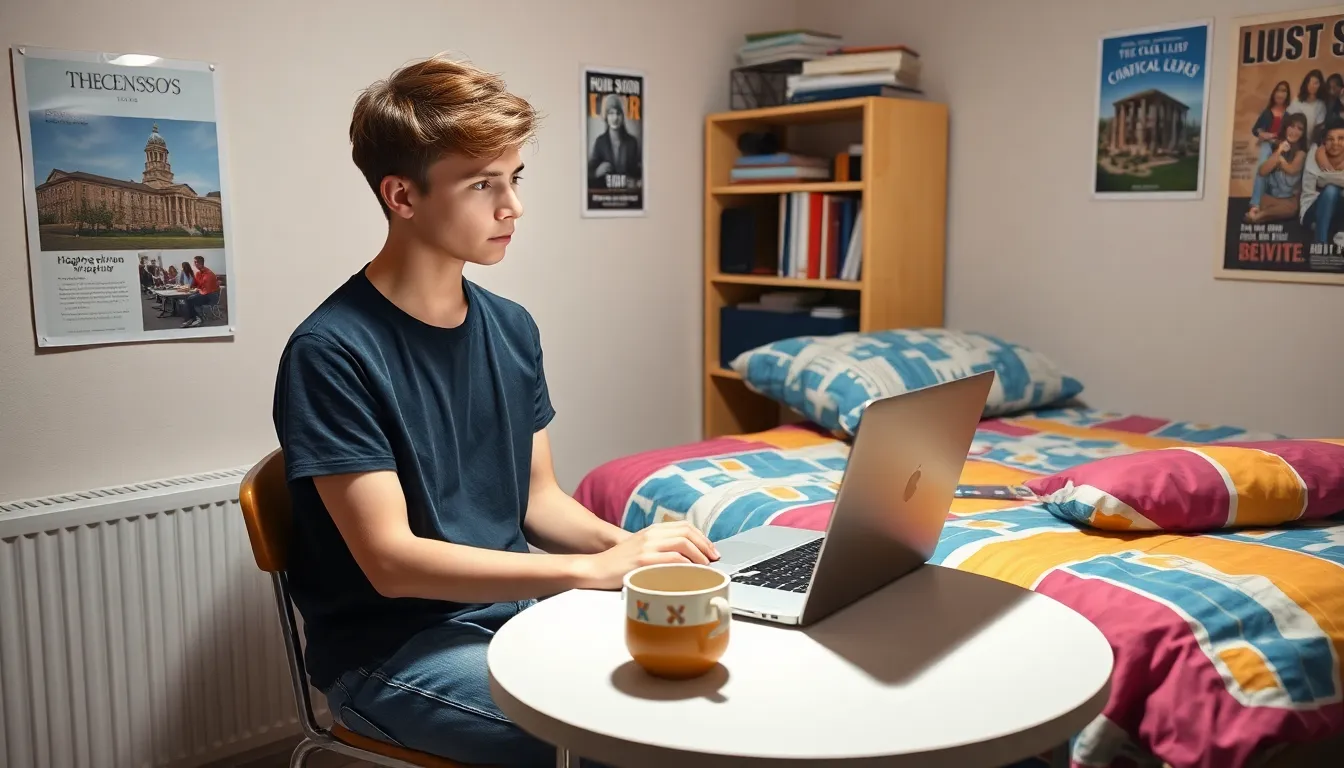Table of Contents
ToggleNavigating the world of student housing can feel like a game of Monopoly—only instead of landing on Park Place, they’re stuck with a cramped dorm room. With tuition bills stacking up, students often wonder whether renting or buying is the smarter move. After all, who wouldn’t want to trade in their shoebox for a cozy little nest?
Renting offers flexibility and fewer responsibilities, perfect for those who prefer a carefree lifestyle. But buying? That could be the golden ticket to equity and a future without pesky landlord rules. As they weigh the pros and cons, students must consider their budgets, lifestyle, and long-term goals. So, should they sign that lease or take the plunge into homeownership? Let’s dive into the details and help them make the best choice for their student years and beyond.
Overview of Student Housing Options
Students have a variety of housing options when attending school. Renting typically provides flexibility. Many students prefer shared apartments or houses, allowing them to split costs. Dormitories often attract first-year students with their social atmosphere. Each option carries unique advantages and challenges.
Buying property can yield long-term benefits. Investors may find that purchasing a home near campus generates rental income. Furthermore, owning a home allows students to build equity over time. However, this commitment requires a significant upfront investment and ongoing maintenance costs.
Cost remains a crucial factor. On average, renting in college towns can range from $400 to $1,500 per month, depending on location and amenities. In comparison, monthly mortgage payments vary significantly based on the property’s value and the down payment. Understanding budget constraints helps students make informed decisions.
Additionally, location impacts the choice between renting and buying. Proximity to campus can determine convenience and commuting times. Houses and apartments near universities often come at a premium but provide valuable access to classes and social events.
Ultimately, lifestyle choices influence housing preferences. Some students thrive in communal living situations, while others seek independence. Evaluating individual needs and financial capabilities assists students in navigating these housing options effectively.
Renting Student Housing

Renting student housing offers flexibility and convenience. Many students opt for rental properties, as they provide a carefree lifestyle with fewer responsibilities. Shared living arrangements reduce costs, making it easier for students to manage monthly expenses. Dormitories attract first-year students due to their social environment, fostering connections and friendships.
Advantages of Renting
Renting allows students to live near campus, enhancing convenience and reducing commuting times. Short-term leases accommodate varying academic schedules, providing flexibility that homeownership lacks. Minimal maintenance responsibilities free up time for studying and socializing. Budgeting becomes easier, as rent payments are predictable, often ranging from $400 to $1,500 per month in college towns. Upfront costs remain low compared to purchasing a home, which attracts many students balancing educational expenses.
Disadvantages of Renting
Renting presents limited control over living spaces and rules set by landlords. Housing quality can fluctuate, and students might face issues with repairs that landlords may not prioritize. Rent hikes occur frequently, increasing monthly expenses year after year. Investment in a rental property doesn’t build equity, leaving students without long-term financial benefits. Additionally, the process of finding suitable housing can be time-consuming, potentially detracting from academic commitments.
Buying Student Housing
Buying student housing offers unique benefits for those considering a long-term investment. Equity accumulation represents one key advantage. As a homeowner, a student builds wealth through property value appreciation. Real estate often appreciates over time, potentially leading to greater financial gains upon sale.
Freedom from landlord restrictions is another crucial benefit. Owning a home allows for customization, such as painting walls or installing new fixtures. Students looking for stability can appreciate the predictable monthly mortgage payments compared to potential rental increases.
Advantages of Buying
Hedging against rising rents stands as a notable advantage of homeownership. Renting in college towns generally ranges from $400 to $1,500 per month, often leading to steep increases over time. With a stable mortgage, students may budget more effectively, ensuring consistent housing costs. Owning property may also allow for the option of renting out a room to other students, creating additional income streams.
Tax benefits often enhance the financial appeal. Homeowners can deduct mortgage interest from their taxes, resulting in considerable savings. Community ties can strengthen too, as students become more invested in their local neighborhoods.
Disadvantages of Buying
Down payments present a significant challenge. Most properties require upfront payments, often 20% of the purchase price, which can strain student finances. Owning a home also includes ongoing maintenance costs, such as repairs or property taxes, potentially adding financial stress.
Selling a property may prove difficult, especially in a fluctuating market. Some students may not stay long enough to justify the investment, risking potential losses. Concerns about value stabilization can further complicate decisions for students primarily focused on their education. Flexibility loss results from committing to a mortgage, especially when shifting academic priorities arise.
Financial Considerations
Students face important financial decisions when contemplating housing options. Understanding the costs associated with renting versus buying is crucial.
Costs of Renting vs Buying
Renting student housing typically incurs monthly payments ranging from $400 to $1,500. This payment includes utilities and requires minimal emotional investment in maintenance. In contrast, buying property necessitates a significant upfront down payment, along with monthly mortgage payments based on property value. Homeownership also comes with ongoing costs like property taxes and maintenance, which renters typically avoid. Renters often benefit from predictable monthly expenses, while homeowners can experience fluctuating expenses due to repairs. Thus, students considering tight budgets may prefer renting due to lower initial costs and fewer financial obligations.
Long-term Investment Potential
Homeownership holds the promise of long-term investment benefits for students. Equity builds over time, offering financial security and potential profit upon selling. As housing values increase, the investment could yield significant returns. Renting, however, lacks this investment potential as payments do not contribute to asset accumulation. Students who prioritize flexibility might choose to rent, yet those with long-term academic plans may consider buying to take advantage of market growth. Tax benefits also accrue for homeowners, adding value beyond just the property itself. Weighing immediate costs against potential returns shapes the financial decision-making process.
Lifestyle Implications
Making a choice between renting and buying student housing carries significant lifestyle implications. Flexibility and mobility often take center stage, along with community engagement.
Flexibility and Mobility
Renting provides students with unparalleled flexibility. Short-term leases cater to varying academic schedules, allowing students to adapt to their changing needs. Students can easily relocate if their circumstances change or they need to find new accommodations. Living arrangements can be shared, thereby helping to reduce costs and foster new friendships. In contrast, buying a home locks students into a commitment, requiring long-term planning and investment. Financial stability plays a critical role, as homeowners face mortgage payments and property maintenance. Flexibility remains a key factor for those focused on transient college experiences, making renting appealing for many students.
Community Engagement
Engaging with the local community becomes simpler when renting near campus. Proximity to local events and social gatherings helps students forge connections with peers and neighbors. This involvement enriches the overall college experience and builds a sense of belonging. Students renting housing often find themselves immersed in vibrant community settings, which can enhance their academic lives. Homeownership may create a more isolated experience, particularly if buyers reside further from campus. Investing in rental properties near educational institutions allows for easier access to resources, supporting both academic achievements and personal growth. Engaging with the community thus plays a pivotal role in shaping students’ overall college experiences.
Deciding between renting and buying student housing is a pivotal choice that can shape a student’s college experience and financial future. Each option presents unique advantages and challenges that cater to different lifestyles and goals. Renting offers flexibility and convenience, making it ideal for those focused on their studies and social engagements. On the other hand, buying property can serve as a long-term investment, providing financial security and potential returns.
Ultimately, students must evaluate their personal circumstances, including financial capacity and future plans. By carefully considering these factors, they can make an informed decision that aligns with their academic journey and lifestyle preferences.




